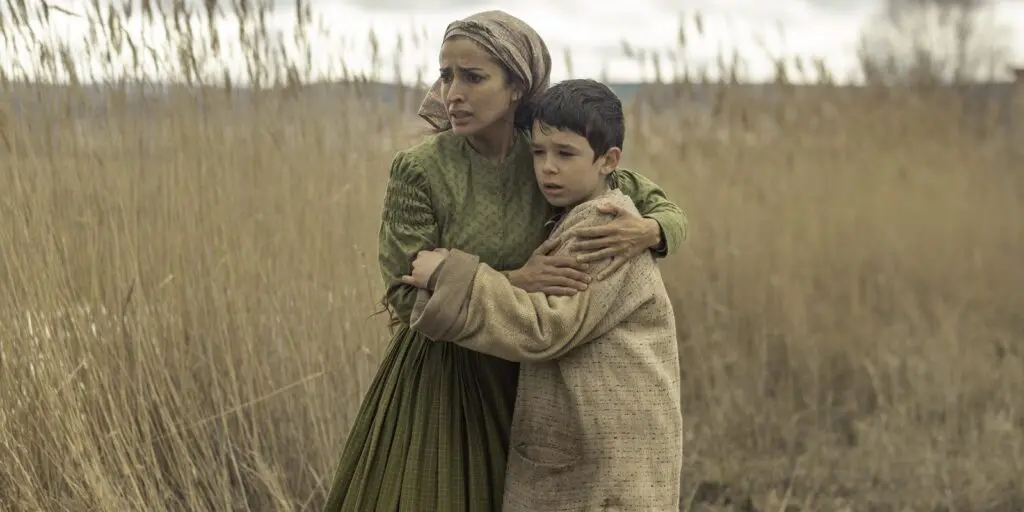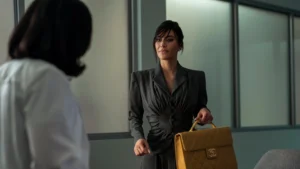While it seems most people don’t like it, I was a fan of David Casademunt’s The Wasteland, or The Beast, an ambiguous Spanish horror film about a mother and her son possibly losing their minds. It’s a movie about quarantining, made in quarantine, and in its atmosphere to its performances, I thought it was a sturdy bit of relatively serious genre filmmaking.
But! It’s also deliberately unclear and largely metaphorical, weaving coming-of-age elements into supernaturalism, which might itself just be a spiraling descent into mental illness thanks to the harshness of the landscape and the indifference of the period.
The ending seems designed to confound and promote speculation rather than provide a definitive conclusion, so this should be fun to unpack.
A Quick Recap
In a broad sense, The Wasteland uses its setting of rural 19th-century Spain, where families have been driven to isolated homesteads in the middle of nowhere to escape a world gripped by chaos and bloodshed, to explore the idea of a young boy losing his innocence.
Diego, who lives with his mother, Lucia, and his father, Salvador, exists in a state of perpetual caution and fear, having to be escorted to the outhouse by one of his parents and a shotgun, and with nothing to play with or look at but his mother’s creepy hand-carved figurines.
Salvador wants to rip the Band-Aid off quickly and expose the festering wound beneath; Lucia, on the other hand, wants to preserve Diego’s innocence as long as possible, which has made him soft and entitled and an absolute liability as the potential dangers get closer and closer to home.
Those potential dangers are embodied by the idea of “The Beast,” a lanky humanoid that feeds on the fear of its victims, being allowed closer and closer by their increasing terror until they’re gripped by worsening madness and eventually kill themselves.
As a horror device – each time it’s sighted, the creature gets closer and closer to the homestead, which ratchets up the tension – this works rather well. But as an idea, it’s less clear. We don’t know, nor are we really intended to, whether Lucia and Diego are being influenced by an external, supernatural force or simply losing their minds.
In my spoiler-free review, I alluded to something that flattens the ending’s impact by revealing ahead of time how the coming-of-age elements are going to interact with the supernatural ones.
Namely, since the creature is tied so intimately to the idea of fear, it is obvious that Diego will eventually confront it without fear, thus conquering both it and his own terror at growing into a world he doesn’t understand and suspects he might not be prepared for.
This predictability saps some of the climax’s power, I thought, but mileage will vary. Either way, while Diego is able to seemingly destroy the beast, Lucia succumbs to her injuries, and the young boy is left alone to fend for himself.
Crucially, the Beast, still alive and reflected in the blackness of Diego’s pupils, can be glimpsed behind him, rendered powerless by his newfound bravery.
Is “The Beast” real?
The crucial question is whether or not the Beast is even real, and I think The Wasteland gives plenty of clues that it isn’t. It never really interacts with characters physically, and the effects of his presence – paranoia, anxiety, distress, violence, self-harm – are all signifiers of mental illness.
When Salvador first recounts the story of this creature to Diego, it’s in relation to his sister, Juana, who was plagued by the Beast until her own death but crucially only became so after significant abuse and trauma, and it was only ever her who was able to see it.
At the end of the first act, Salvador discovers a badly wounded man in a creek, and he is nastily killed not long after being nursed back to health. Salvador decides he must deliver the corpse to the man’s family and explain what happened, so he leaves Diego and Lucia alone, at the mercy of an inhospitable environment.
Lucia is driven to madness by her surety that Salvador has died on the trip, and thus the realization that she alone is now responsible for protecting Diego, whom she recognizes isn’t prepared for the world at least in part because of her own coddling of him. This, as well as her own worsening madness, helps to explain why Lucia becomes so forceful and unsympathetic towards Diego, forcing him to kill and eat the rabbits who’re his only friends and highlighting on his own body the areas in which he is to stab the Beast if things come to that.
Quite by chance, these lessons are learned just as Lucia becomes unable to continue, so Diego saves her from her own attempt at suicide and then again from the Beast, though she succumbs to her injuries later.
The idea of the Beast still being alive behind Diego at the very end is, I think, a suggestion that despite him having overcome his fear, it remains with him, waiting to claim him if he ever allows himself to be terrified and vulnerable again.




